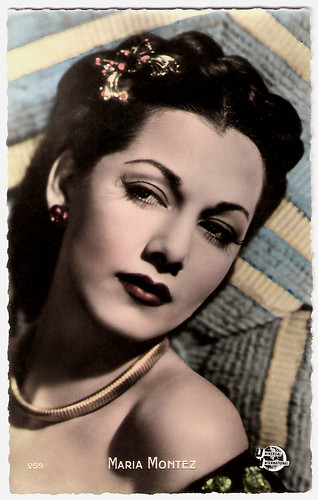
French postcard by Editions P.I., no. 259. Photo: Universal International.
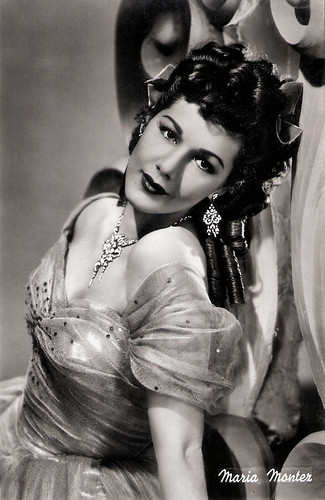
Italian postcard by Rotophot, Milano, no. 14.

Spanish postcard by Archivo Bermejo, Barcelona. Photo: Universal. Photo: publicity still for Sudan (John Rawlins, 1945).

French postcard by Editions "Votre Vedette" (E.V.V.), no. 142. Photo: Universal Film.

French postcard by Editions O.P., Paris, no. 28. Photo: Studio Harcourt.
The Caribbean Cyclone
Maria Montez was born Maria Africa Gracia Vidal in Barahona, Dominican Republic in 1912. She was one of ten children born to Isidoro Gracía, and his wife Teresa Vidal. Her father was a textile exporter and the Honorary Vice Consul of Spain in the Dominican Republic. Despite what several sources write, Montez lived the first 27 years of her life in the Dominican Republic.
In 1932 she married William G. McFeeters, a wealthy banker who served in the British army. In 1939 they divorced and Maria moved to New York City, where she worked as a model. She was discovered by a Universal talent scout and left for Hollywood.
One of her first films for Universal was the Science Fiction comedy The Invisible Woman (A. Edward Sutherland, 1940) in which she had a bit part as a model. In the B-Western Boss of Bullion City (Ray Taylor, 1940) starring Johnny Mack Brown, Montez was the female lead. It was the first time she played a leading role and was the only one of her film roles where she speaks some Spanish. South of Tahiti (George Waggner, 1941) with Brian Donlevy and Broderick Crawford, helped to launch her as a pin-up star.
Her beauty soon made her the centrepiece of Universal's Technicolor costume adventures. Her most frequent costar was Jon Hall, who some critics claimed was even prettier and better built than she was. Their joint films were the big hit Arabian Nights (John Rawlins, 1942) with Sabu, White Savage (Arthur Lubin, 1943), Ali Baba and the Forty Thieves (Arthur Lubin, 1944) with Turhan Bey, the camp classic Cobra Woman (Robert Siodmak, 1944), Gypsy Wildcat (Roy William Neil, 1944), and Sudan (John Rawlins, 1945).
Hal Erickson at AllMovie: “A 24-hour-a-day star, Ms. Montez was famous for her spectacular entrances at nightclubs and social functions; once, when her arrival at the Universal commissary failed to attract notice, she turned her heel and left the room, returning moments later with a huge entourage and accompanying loud noises.”
‘The Caribbean Cyclone’ often quarrelled with her directors and went on suspension for refusing the lead in the Western Frontier Gal (Charles Lamont, 1945). Her role was taken by Yvonne de Carlo who had become a similar sort of star and began to supplant Montez's position at the studio. Montez then appeared in the sepia-toned swashbuckler The Exile (Max Ophüls, 1947) starring Douglas Fairbanks, Jr., and the Technicolor Western Pirates of Monterey (Alfred L. Werker, 1947) with Rod Cameron. It was to be her last film for Universal.
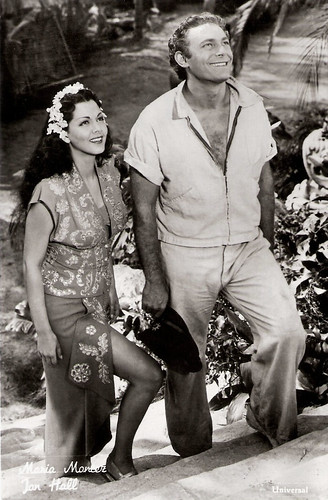
Maria Montez and Jon Hall in White Savage (1943). Vintage card. Photo: Universal. Publicity still for White Savage (Arthur Lubin, 1943).
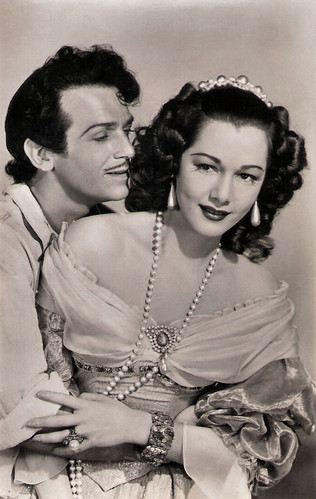
Maria Montez and Douglas Fairbanks Jr. in The Exile (1947). Spanish postcard by Sobe, no. 452. Photo: publicity still for The Exile (Max Ophüls, 1947).

Maria Montez and Jean-Pierre Aumont. Dutch postcard, no. A x 447.
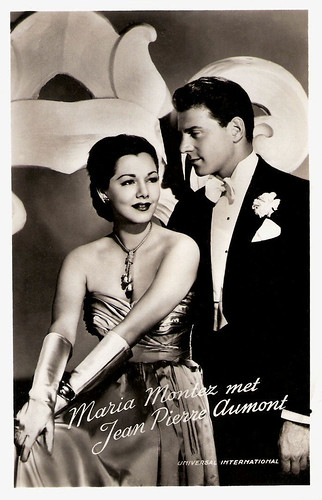
Maria Montez and Jean-Pierre Aumont. Dutch postcard, no. 3117. Photo: Universal International.
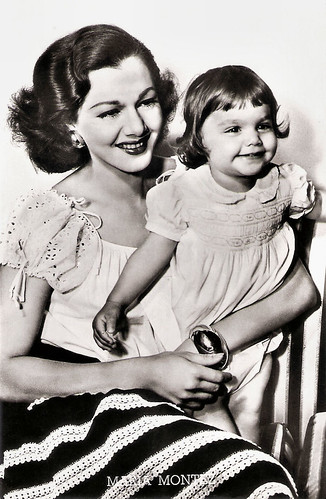
Maria Montez and Tina Aumont. Vintage postcard, no. 301.
Sadistic manager of a circus show
While working in Hollywood, Maria Montez met French actor Jean-Pierre Aumont. They married in 1943 at Montez's home in Beverly Hills. Aumont had to leave a few days after their wedding to serve in the Free French Forces fighting against Nazi Germany during World War II. At the end of the war, the couple had a daughter, Maria Christina (also known as actress Tina Aumont), born in Hollywood in 1946.
The couple starred together in the American adventure film Siren of Atlantis (Gregg G. Tallas, 1949), produced by United Artists. It was the first film Montez made after leaving Universal Pictures. By then, her career in the United States began to wane due to audiences' changing taste in films.
Montez and Aumont then moved to a home in Suresnes, a western suburb of Paris. In France, Montez appeared in several films and the play L'Ile Heureuse (The happy island), written by her husband. Her first French film was Hans le marin/Wicked City (François Villiers, 1949) with Jean-Pierre Aumont and Lilli Palmer. It was a success in Europe.
She then played the sadistic manager of a circus show, who uses her attractiveness to seduce men and force them to do dangerous acrobatic acts in Portrait d'un assassin/Portrait of an Assassin (Bernard-Roland, 1949). One of her victims was played by Erich von Stroheim.
She also wrote three books, two of which were published, as well as penning a number of poems. In Italy, she starred in the Italian-American coproduction Il Ladro di Venezia/The Thief of Venice (John Brahm, 1950) with another former Universal contract star, Paul Christian a.k.a. Paul Hubschmid. Her last film was the Italian adventure film La vendetta del corsaro/Revenge of the Pirates (Primo Zeglio, 1951).
At only 39, Maria Montez died in Suresnes, France in 1951 after apparently suffering a heart attack and drowning in her bath. She was buried in the Cimetière du Montparnasse in Paris where her tombstone gives her amended year of birth (1918), not the actual year of birth (1912). Shortly after her death, a street in the city of Barahona, Montez's birthplace, was named after her. In 1996, the city of Barahona opened the Aeropuerto Internacional María Montez (María Montez International Airport) in her honour.

Dutch postcard, no. 3208. Photo: Universal International.

Dutch postcard by Fotoarchief Film en Toneel, no. 3221. Photo: Universal-International.

Dutch postcard.
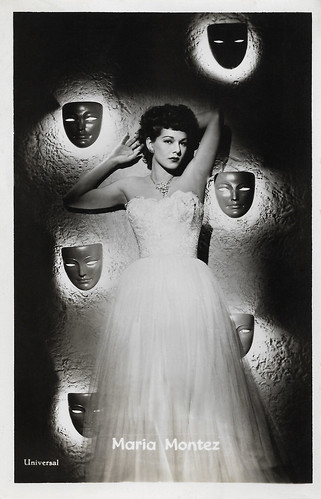
Vintage card. Photo: Universal.

Belgian postcard, no. 950. Photo: Universal Film.

Spanish card, 1948. Photo: Universal. Publicity still for Arabian Nights (John Rawlins, 1942).

Spanish postcard by Archivo Bermejo, Barcelona. Photo: Universal. Maria Montez in Sudan (John Rawlins, 1945).

French postcard by Editions P.I., no. 259. Photo: Universal International.
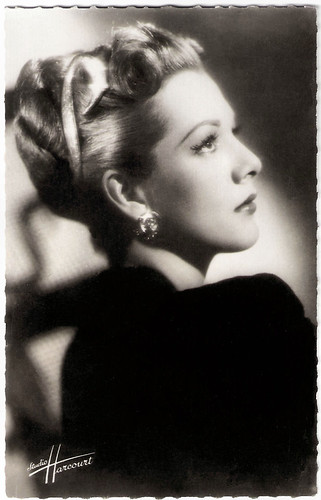
French postcard by Editions O.P., Paris, no. 28. Photo: Studio Harcourt.
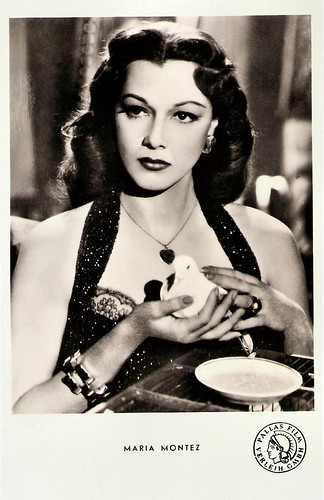
German postcard by Kunst und Bild, Berlin, no. A 292. Photo: Pallas Film Verleih.

German postcard by Kolibri-Verlag. Photo: Universal International.

German postcard by Kunst und Bild, Berlin, no. A 556. Photo: Universal International. Photo: publicity still for The Exile (Max Ophüls, 1947).

British Real Photograph postcard, no. F.S. 61, ca. 1948. Caption: Lovely Maria Montez who recently starred opposite Douglas Fairbanks Jr. in The Exile, is now to be seen as the Queen in Siren of Atlantis.

Italian postcard by C.C.M., no. 16, presented in Belgium by NV Victoria, Brussels, no. 638. Photo: Universal International.
Sources: Hal Erickson (AllMovie), Denny Jackson (IMDb), Wikipedia, and IMDb.
This post was last updated on 10 September 2021.
No comments:
Post a Comment